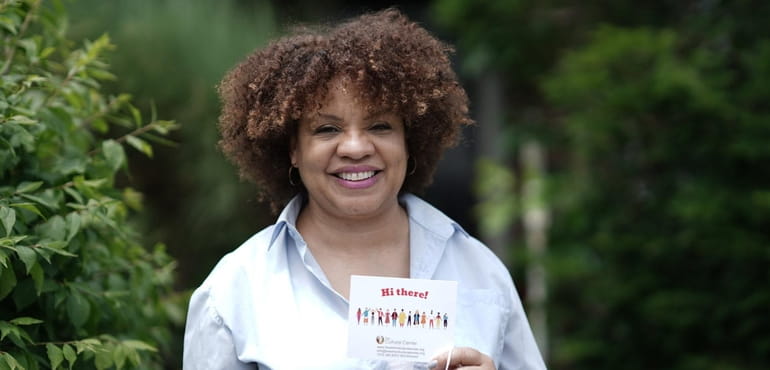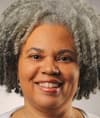Census Bureau-takers get 'creative in the midst of the COVID pandemic'

Mimi Pierre Johnson, a community activist in Elmont involved in census outreach, mailed informational postcards to Elmont residents. Credit: Debbie Egan-Chin
The coronavirus pandemic put on pause Census 2020 in-person outreach efforts, with nonprofit, volunteer and government efforts shifting largely to virtual means of promoting the census, or by distributing informational flyers at food distribution sites, virus testing sites and through mailings.
"We’ve had to be creative in the midst of the COVID pandemic," said Vanessa Baird-Streeter, Suffolk County's deputy county executive for community recovery.
For example, Baird-Streeter said people who were tested for the coronavirus at the county's six "hot spot" testing sites in heavily populated minority communities received a resource packet. "We've tested 8,400 individuals, and they got census information," she said.
George Siberon, executive director of the Hempstead Hispanic Civic Association, said he has attended all of the food distribution sites hosted by Nassau County and Island Harvest food bank to pass out flyers.
As of Wednesday morning, the Census Bureau's self-response rate map showed New York's overall rate was 56.7%, below the national rate of 61.4%. There's great variation in response rates across New York's 62 counties, with Nassau having the highest: 67.5%. Suffolk's rate was 61.3%.
"It is paramount that New Yorkers complete their census questionnaire so that New York is fully represented in Congress and we receive our full share of federal funding," said Kristin Devoe, spokeswoman for the Empire State Development Corp.
Those involved in outreach said the census — a once-a-decade count of the nation's population — ensures that localities across Long Island get the financial resources for about 100 programs, spanning health care, education, transportation and more. The census dictates the distribution of an estimated $675 billion in federal funding annually to the states and their municipalities.
The virus caused the Census Bureau to suspend field operations in April. Some operations resumed earlier this month. The bureau's counting of people who haven't filled out a census form — which can be done online, by phone or by mailing in the questionnaire — was delayed from May until Aug. 11.
Jeff T. Behler, the U.S. Census Bureau’s regional director for New York, said he was encouraged by New Yorkers' response. "As things reopen, New York has, at times, been leading the nation in the growth in self-response rates. I'm amazed," he said.
Mimi Pierre Johnson, a community activist in Elmont involved in census outreach, said she has printed informational postcards and mailed them to Elmont residents.
"I don’t want to be called hard to count any more," Johnson said. Concerned about the disparity in resources between heavily populated minority communities, considered hard to count in the census compared with predominantly white ones, Johnson said her goal was to get residents of minority communities to understand how the census "is your opportunity to change all that … I want to be equal to the North Shore and Garden City. "
Many nonprofits and county officials note the East End of Suffolk has many communities that don't receive mail delivery at their home addresses, but only at post office boxes. The Census Bureau does not deliver to post office boxes. As a result, many haven't received their Census 2020 invitation, and census self-response rates are low.
Behler said staff is now dropping off census materials, including the paper questionnaire, to those East End addresses, and elsewhere on the Island. The Census Bureau only delivers census materials to home addresses, not post office boxes, to ensure accuracy, Behler said. Bureau staff had begun about two weeks ago, he said, to hand-deliver census packets to about 28,000 addresses in Suffolk, and about 1,500 in Nassau.
The City University of New York Center for Urban Research Graduate Center's mapping service also provides a census self-response rates map, which showed large swaths of the East End had only a 10% self-response rate. Officials with the towns of Southampton and East Hampton said they are aware of the low response rate, which they attributed to the post office box issue, and were considering sending census postcards to residents to boost awareness.
"Census data is used to fund emergency services desperately needed during this pandemic. We cannot possibly leave any dollar on the table," said Rebecca Sanin, president and chief executive of the Health and Welfare Council of Long Island, who is coordinating the Complete Count Committee effort for Nassau and Suffolk counties.

Updated now Newsday travel writer Scott Vogel took the ferry over to Block Island for a weekend of fun.

Updated now Newsday travel writer Scott Vogel took the ferry over to Block Island for a weekend of fun.

